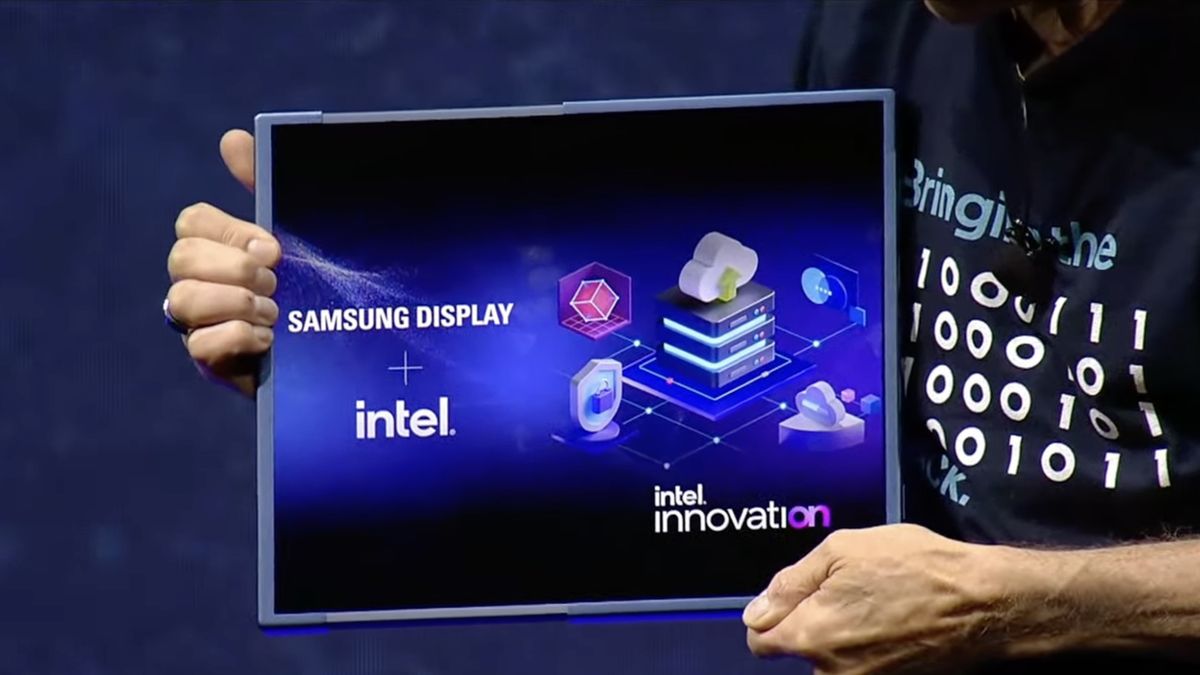Samsung wants to replace foldable screens with new slidable PCs
Samsung is betting on a slidable screen future

What you need to know
- Samsung showed off a slidable display that makes it easy to transform a 13-inch tablet to a 17-inch monitor.
- The Samsung concept slidable PC resembles LG's concept Rollable smartphone.
- Samsung envisions that slidable PCs could someday overtake foldables.
- The Samsung concept was shown off at Intel's Innovation conference this year.
While Samsung has built a name for itself in the mobile space with foldable phones, like the Galaxy Z Flip and Galaxy Z Fold series, the company is exploring new innovative screen technology for PCs. During Intel's Innovation keynote, Samsung and the chip-maker showed off a concept PC with a screen that rolls out from the chassis to expand, rather than fold, to create a larger display experience.
Samsung showed off its slidable PC concept, revealing a rollable display that can transform a 13-inch tablet into a larger 17-inch display during Intel's keynote.
“We’re announcing the world’s first 17-inch slidable display for PCs,” Samsung Display CEO JS Choi said in announcing the new concept.
The sliding screen technology comes with several advantages over folding screens, like those currently employed on Samsung's phones. Various pain points reported by owners of Samsung's foldable phones include a display that is more delicate than a standard smartphone, a prominent crease in the screen where the fold happens that can detract from the user experience, and a high price tag. The sliding screen should help alleviate the prominent screen crease and the mechanism can potentially lead to more durable displays in the future.
In reality, Samsung's prototype PC's display is very similar to what LG had envisioned for a rollable phone. The Samsung concept PC actually resembles a larger version of the LG Rollable concept. Unfortunately, the LG Rollable never materialized, and the product was pulled ahead of LG's exit from the mobile phone space.
With the rollable display form factor, Samsung would be able to create a single device that spans tablet, laptop, and desktop form factors. In tablet mode, the device can convert into a laptop with a keyboard folio, not unlike current foldable PCs like the Lenovo ThinkPad X1 Fold or the Asus ZenBook 17 Fold, and when unrolled, the slidable form factor delivers a much larger canvas that can mimic a desktop monitor.
Beyond laptops, tablets, and mobile form factors, foldable screen technology has also showed up on desktop displays more recently. Corsair's Xeneon Flex, for example, is an ultra-wide monitor where the sides can fold in to create a curved display for more immersive gaming.
Get the Windows Central Newsletter
All the latest news, reviews, and guides for Windows and Xbox diehards.
Though Lenovo came out with its foldable ThinkPad a few years ago, the product remains a niche offering. Even if Samsung is ready to move beyond foldable to slidable PCs, it's unclear if the company will be able to displace the foldable market. Neither company has revealed any plans for a launch, and it's unclear how much slidable PCs will cost if they do hit the market.
Like with foldable PCs before it, Samsung and Intel will have the challenge to get developers to get behind the new slidable form factor. Aside from the space-saving utility of a more compact display for travel, software will need to be optimized for this new display technology, and developers will need to create new user experiences that make adoption of this new display worthwhile for PC shoppers.
In addition to showcasing Samsung's slidable PC concept, Intel also announced its new 13th Gen processor lineup during the Innovation conference.
Chuong's passion for gadgets began with the humble PDA. Since then, he has covered a range of consumer and enterprise devices, raning from smartphones to tablets, laptops to desktops and everything in between for publications like Pocketnow, Digital Trends, Wareable, Paste Magazine, and TechRadar in the past before joining the awesome team at Windows Central. Based in the San Francisco Bay Area, when not working, he likes exploring the diverse and eclectic food scene, taking short jaunts to wine country, soaking in the sun along California's coast, consuming news, and finding new hiking trails.
